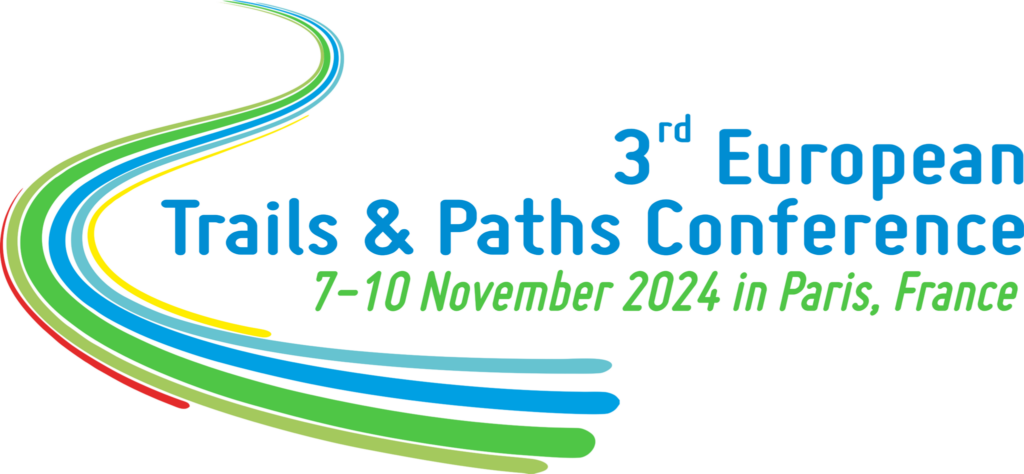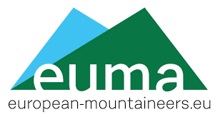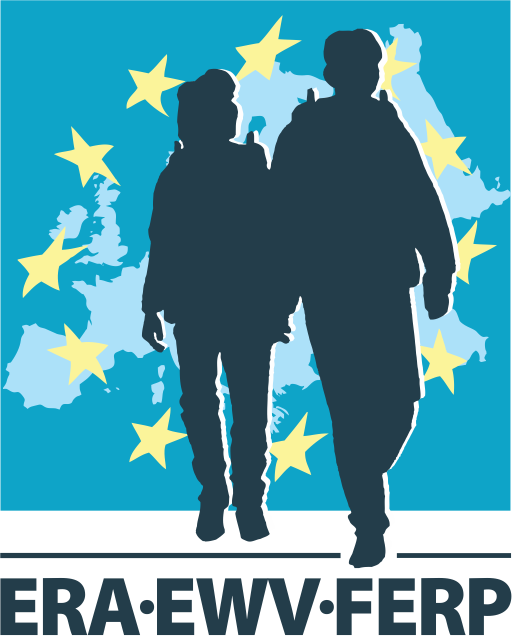Photo: John Pucknell
Updated 11-11-2024

.
EUROPEAN RAMBLERS’ ASSOCIATION (ERA)
EUROPEAN MOUNTAINEERING ASSOCIATION (EUMA)
in cooperation with
FÉDÉRATION FRANÇAISE DE LA RANDONNÉE PÉDESTRE (FFRP)
organized
the 3rd EUROPEAN TRAILS AND PATHS CONFERENCE
with the main topic
“TRAILS SUSTAINABILITY“
.



Date:
7 – 10 November 2024, in Paris, France.
Place:
Hôtel CIS Paris Ravel, 6 Av. Maurice Ravel, 75012 Paris, France
Conference objectives and outcomes
Key themes:
1. Trail sustainability and maintenance
2. Climate resilience and trail infrastructure
Objective:
The conference aimed to foster collaboration among European trail organizations, emphasizing sustainable trail management practices, promoting inclusivity in trail usage and governance. The conference provided an excellent opportunity for trail organizations to establish valuable connections, fostering potential collaborations and partnerships that can enhance the implementation of sustainable trail management practices and membership engagement initiatives. The sharing of best practices and successful case studies during the event inspired and motivated trail organizations to adopt innovative approaches, leading to the development of more effective strategies for trail management and membership engagement.
Outcomes:
The output document will be presented to the EU Commission and to the CoE (Commission of Landscape Convention and EPA). Proceedings with conclusions will be available in electronic format.
Conference Programme
| Thursday, 07.11. | |
| Arrival of participants Welcome | |
| 19:00-20:30 | Dinner |
| Friday, 08.11. | |
| Breakfast in your hotel | |
| 09:00-12:30 | Block I Presentations & Discussions |
| 12:30-14:00 | Lunch |
| 14:30-18:00 | Block II Presentations & Discussions |
| 19:00-20:30 | Dinner Networking |
| Saturday, 09.11. | |
| Breakfast in your hotel | |
| 09:00-13:00 | Block III Presentations & Discussions |
| 13:00-14:00 | Lunch |
| 14:00 | Organized visit to the Olympic site – city hike (walking shoes and appropriate clothing for rainy Paris recommended) |
| 19:00-20:30 | Dinner Networking |
| Sunday, 10.11. | |
| Breakfast in your hotel | |
| 09:00-11:00 | The final output of the 3rd European Trails and Paths Conference Conclusions of the conference |
| @11:00 | Expected end of the conference Departure |
Conference Topics / Abstracts
Presentations
Block 1
1.1 Sustainable Trail Management in Europe (Andreas Aschaber, EUMA)
Summary: This abstract emphasizes the essential role of trails in European cohesion, providing a sustainable network for hiking and mountaineering. It discusses the challenges in managing and maintaining trails, especially in the face of legal uncertainties, climate change, and urbanization. The findings, derived from data across 30 European countries, reveal the need for a Europe-wide trail management system. The research supports the development of a more nature-sensitive trail management approach that secures the future of Europe’s 15 million km of trails.
1.2 EUMA’s Interactive Database and Map System (Alessio Piccioli, EUMA)
Summary: The introduction of a comprehensive interactive database and map system for trails marks a major advancement for EUMA. This system allows for the standardization of trail information across Europe, ensuring accessibility and data uniformity for trail maintenance. Utilizing OpenStreetMap data and leveraging volunteer efforts, this initiative enhances environmental stewardship and supports responsible outdoor recreation.
1.3 Safe and Sustainable Mountaineering Infrastructure in Croatia (Hrvoje Gold, CMA)
Summary: This project by the Croatian Mountaineering Association, in partnership with the Ministry of Tourism and Sport, focuses on the development and maintenance of Croatia’s mountaineering infrastructure, which includes over 6500 km of trails and 160 shelters. The initiative seeks to secure long-term government support for maintaining trails as part of Croatia’s public tourism infrastructure. The project is built on decades of data collection and aims to ensure the sustainable use of Croatia’s mountaineering trails.
1.4 Digitize the Planet (Thorsten Unseld, Digitize the Planet e.V.)
Summary: This initiative tackles the challenge of managing digital activity to support environmental sustainability. As outdoor enthusiasts increasingly rely on digital tools, there is a growing need for accessible information about protected areas and their rules. The proposal is to create a comprehensive open data set that integrates environmental regulations and guidelines with digital navigation platforms. The goal is to guide visitors responsibly and reduce conflicts between nature conservation and human activities.
1.5 National Observatory of Pedestrian Traffic (Iris Héran-Gobert & Christophe Martinez, FFRandonnée)
Summary: This project responds to the increasing popularity of hiking in France, especially post-COVID. The rise in pedestrian traffic poses risks to natural areas and requires careful management. The National Observatory of Pedestrian Traffic aims to quantify and analyze pedestrian traffic on hiking trails using tools like GPS data from millions of users. These insights will help preserve natural areas and guide sustainable trail management.
Block 2
2.1 Guillaume Bernard – Trail Maintenance and Sustainability in Europe
Summary: This presentation outlines the key causes of damage to trails, including natural events like storms, floods, and avalanches, as well as human activity and neglect. It emphasizes the importance of early detection of damage, slope stabilization, and water management. Solutions focus on using local materials and maintaining collaboration among municipalities, nature parks, and volunteers. Sustainability is central, with water damage highlighted as the main cause of trail degradation.
2.2 Johanne Burgemann – Gendarmstien Case Study: Best Practices for Trail Maintenance
Summary: This case study focuses on the Gendarmstien, a long-distance trail in Denmark, and how it recovered after severe storm damage in 2023. The presentation describes the environmental impact of the storm surge and the trail’s subsequent restoration through collaboration with landowners and environmental efforts. However, parts of the trail remain vulnerable to future weather events, and further adaptation may be necessary.
2.3 Bojan Rotovnik – Climate Change Effects on Mountain Trails
Summary: This presentation covers the diverse impacts of climate change on mountain trails, including glacier retreat, storms, flooding, and the desertification of trails. It highlights the challenges faced by national mountaineering associations in adapting to these changes and the importance of volunteer work in maintaining trails.
2.4 Liane Jordan – Climate-Adapted Quality Transformation
Summary: This project, initiated by the German Hiking Association, is investigating how changes due to climate change will affect hiking trails, their infrastructures and the landscape. The aim of the project is to make hiking tourism in Germany more resilient and future-proof by using digital tools and analyzing the effects of climate change. The basis for the analyses is a survey of trail managers on the changes to hiking trails. The results will be used to create a guide to help people adapt better to extreme situations and make hiking more resilient. In addition, a digital quality monitoring system is being developed for faster recording of influences on hiking trails.
2.5 Ioannis Lagos & Georgios Koulalis – Climate Change, Fires, and Trails
Summary: This presentation focuses on the Menalon Trail in Greece and the efforts to protect it from wildfires, which are exacerbated by climate change. It describes the role of local volunteers and digital communication in coordinating fire prevention and response efforts. The presentation also touches on the broader issue of urbanization and its impact on fire prevention, as fewer people remain in rural areas to manage and protect forests.
2.6 Boudewijn Blom-Hertbeek – Conflicts Between Stakeholders in Trail Use
Summary: This presentation addresses rising conflicts between hikers and mountain bikers, exacerbated by increased trail erosion and differing expectations. Proposed solutions include spatial separation of activities, applying traffic rules to trails, and raising awareness among all stakeholders. The presentation suggests that E-trails could serve as testing grounds for these conflict-mitigation measures.
Block 3
3.1 Cécile Legrand – Development of New Practices and Their Environmental Impact
Summary: The French Hiking Federation (FFRandonnée) examines the growing popularity of hiking and its environmental impact. It explores how the diversification of hiking practices, particularly after COVID, has strained ecosystems. FFRandonnée has conducted studies to assess these impacts and proposes new sustainable practices like “Fast Hiking” to address them.
3.2 Angelo Latorre – Via Romea Sanesa Accessible: A Cultural Route Meets Social Inclusion
Summary: This presentation discusses how the Via Romea Sanesa cultural route has been made accessible to elderly people and those with disabilities. It suggests that accessibility improvements can be made without significant financial investments by using practical technological aids.
3.3 Perrine Démoulins – Hiker’s Charter
Summary: FFRandonnée is updating its Hiker’s Charter to raise awareness among hikers, particularly new ones, about sustainability, biodiversity, and safety. The goal is to create innovative communication tools that engage hikers digitally and internationally, aiming to reduce environmental impact and conflicts on the trails.
3.4 Steen Kobberø-Hansen & Liane Jordan – Status and Development of E-Paths, LQT, and Green Trails
Summary: This presentation highlights ERA’s work on E-Paths, Leading Quality Trails (LQT), and Green Trails. It discusses the expansion of E-Paths, the development of Quality Day Walks, and the integration of sustainability into trail certification through the Green Trails initiative. ERA aims to enhance the hiking experience while promoting environmental conservation.
3.5 Andreas Mayr, Martin Rutzinger, & Michael Rosendorfer – PAW: Engaging a Highly Qualified Crowd as Human Sensors for Natural Hazards
Summary: Project AlpsWatch (PAW) engages professional mountain guides and rescue teams as “human sensors” to monitor natural hazards in alpine regions. Using a web app, these trained individuals can document hazards, which will provide data for researchers and local authorities. This initiative aims to improve safety and inform policy decisions related to natural hazard management.
3.6 Asnāte Ziemele – Trails for All and Everyone: Accessible Hiking Trails in the Baltic Countries
Summary: This project addresses accessibility on the Forest and Coastal Hiking Trails in the Baltic countries, improving access for people with disabilities, seniors, and families. The project includes physical adaptations (e.g., floating wheelchairs, audio guides) and specialized signage, aiming to make these trails inclusive for all hikers.


 Walk for unity & wellness!
Walk for unity & wellness! 


